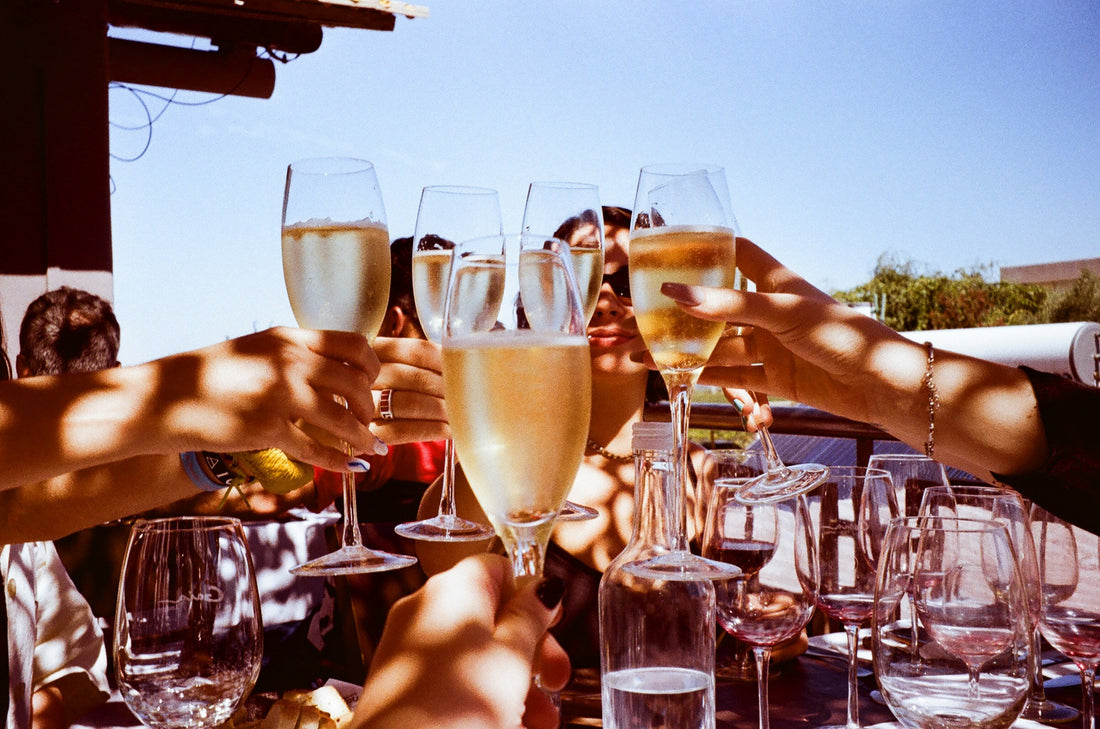
Rosé Champagne: A Celebration of Nuance, Method, and Gastronomic Delight
Share
Rosé Champagne: A Celebration of Nuance, Method, and Gastronomic Delight
Crafting the Pink Hue: Assemblage vs. Saignée
-
Assemblage (Blending): The Art of Precision
- Method: This is the predominant technique used today, especially by larger houses seeking consistency. It involves adding a small percentage (anywhere from 5% to 20%) of still red wine, meticulously produced from Champagne's Pinot Noir or Pinot Meunier grapes, to the white base wine blend *before* the crucial secondary fermentation in the bottle.
- Control & Style: This method grants the *chef de cave* exceptional control over the final color intensity and aromatic profile. By selecting specific red wines for their fruit character, structure, or color, they can fine-tune the blend year after year. Assemblage Rosés often prioritize elegance, subtlety, consistent fruit expression (typically fresh red berries), and a seamless integration of components.
- Quality Factor:** The quality of the added red wine is paramount; subpar red wine will detract from the final blend's finesse. Top houses dedicate specific plots and vinification techniques solely for producing high-quality red wine for their Rosé assemblage.
Saignée (Bleeding): The Path of Terroir & TextureMethod: This more ancestral and technically demanding method involves direct maceration. Black grape skins (Pinot Noir and/or Meunier) are left in contact with the freshly pressed clear juice for a carefully controlled period – ranging from a few hours to perhaps two days – allowing color, flavor compounds, and tannins to be gently extracted into the must. When the winemaker judges the extraction optimal, the now-pink juice is "bled" off (*saignée*) the skins and fermented like a white wine.Challenges & Style: The Saignée method requires immense precision and intuition, as maceration times must be judged perfectly based on grape ripeness, skin thickness, and desired style – variations of minutes can significantly impact the final wine. Consequently, Saignée Rosés often exhibit deeper, more variable colors (from vibrant pink to almost light red), more intense and sometimes darker fruit profiles (cherry, plum, blood orange), greater palate weight, more pronounced structure, and occasionally a subtle tannic grip. They are often seen as more expressive of the specific vintage and vineyard site, showcasing a bolder, more vinous character. Consistency year-to-year is harder to achieve than with assemblage.
A Spectrum of Styles: More Than Just Pink
- Ethereal & Aperitif Style: Often pale salmon or petal pink, usually made via assemblage with significant Chardonnay influence. Characterized by delicate aromas of wild strawberry, raspberry, pomegranate seeds, rose petals, and citrus zest. Light-bodied, crisp, with high acidity and a focus on freshness. Ideal for sipping on its own or with very light starters.
- Fruity & Sociable: Displaying a brighter pink hue, these can be assemblage or lighter Saignée styles, frequently with a good proportion of Pinot Meunier lending juicy accessibility. Expect more overt red fruit notes like cherry, ripe raspberry, perhaps a hint of candy. Rounded, charming, and perfect for gatherings, picnics, or lighter fare.
- Gastronomic & Structured: Often deeper in color (copper, cerise), typically Saignée or assemblage Rosés with a high percentage of quality Pinot Noir, potentially including some barrel influence. These offer greater palate weight, firmer structure, savory complexity alongside darker berry fruit, notes of spice, orange peel, sometimes earthy or even slightly smoky elements. They possess significant aging potential and demand food.
- Vintage Rosé: The Year in Pink: Produced only in top harvest years, Vintage Rosé captures the unique signature of that specific season. Whether assemblage or Saignée, these wines invariably offer enhanced concentration, depth, complexity, and cellaring potential compared to their NV counterparts, reflecting the vintage's specific climatic imprint on the grapes.
- Prestige Cuvée Rosé: The Apex: Representing the absolute pinnacle from a Champagne house, these are crafted from the most exceptional vineyard plots, often involving highly specific techniques (like meticulous grape sorting, co-fermentation of white and red grapes, partial oak aging) and benefit from extended lees aging (often a decade or more). Examples like Dom Pérignon Rosé, Krug Rosé, or Cristal Rosé offer unparalleled complexity, longevity, and profound sensory experiences.
Addressing the Sweetness Question
Pairing Prowess: Rosé's Culinary Canvas
- Delicate Rosés: Superb with sushi/sashimi (especially tuna or salmon), shrimp cocktail, carpaccio (beef or tuna), light salads with berries and vinaigrette, fresh goat cheese, or simple grilled prawns.
- Fruit-Forward Rosés: Pair beautifully with charcuterie boards, country pâtés, prosciutto and melon, grilled salmon steaks, wood-fired pizza with cured meats, or even classic roast chicken.
- Structured/Vinous Rosés: Can confidently accompany richer dishes like seared duck breast with a berry reduction, grilled lamb chops with herbs, pan-seared tuna steaks, roasted game birds (quail, pheasant), mushroom tartlets, or even lighter beef preparations like steak tartare or carpaccio.
- Cheese Pairings: Beyond goat cheese, try Brie or Camembert with fruitier styles, or explore pairings with washed-rind cheeses or aged Comté for more structured Rosés.
- Desserts (Off-Dry/Demi-Sec Rosé): While most quality Rosé is Brut, sweeter styles are delightful with red fruit-based desserts – think raspberry mille-feuille, strawberry shortcake, cherry clafoutis, or simply chocolate-dipped strawberries.
